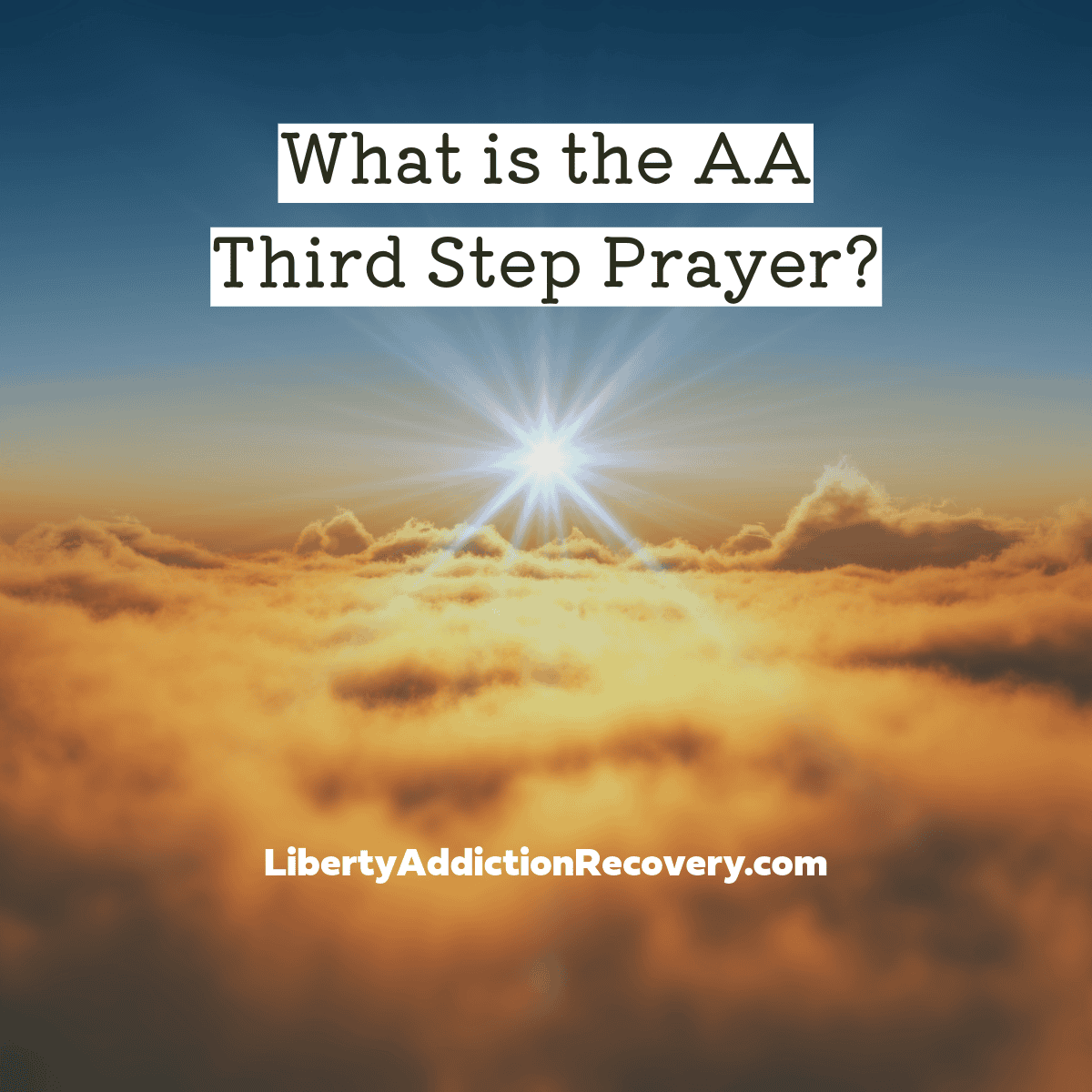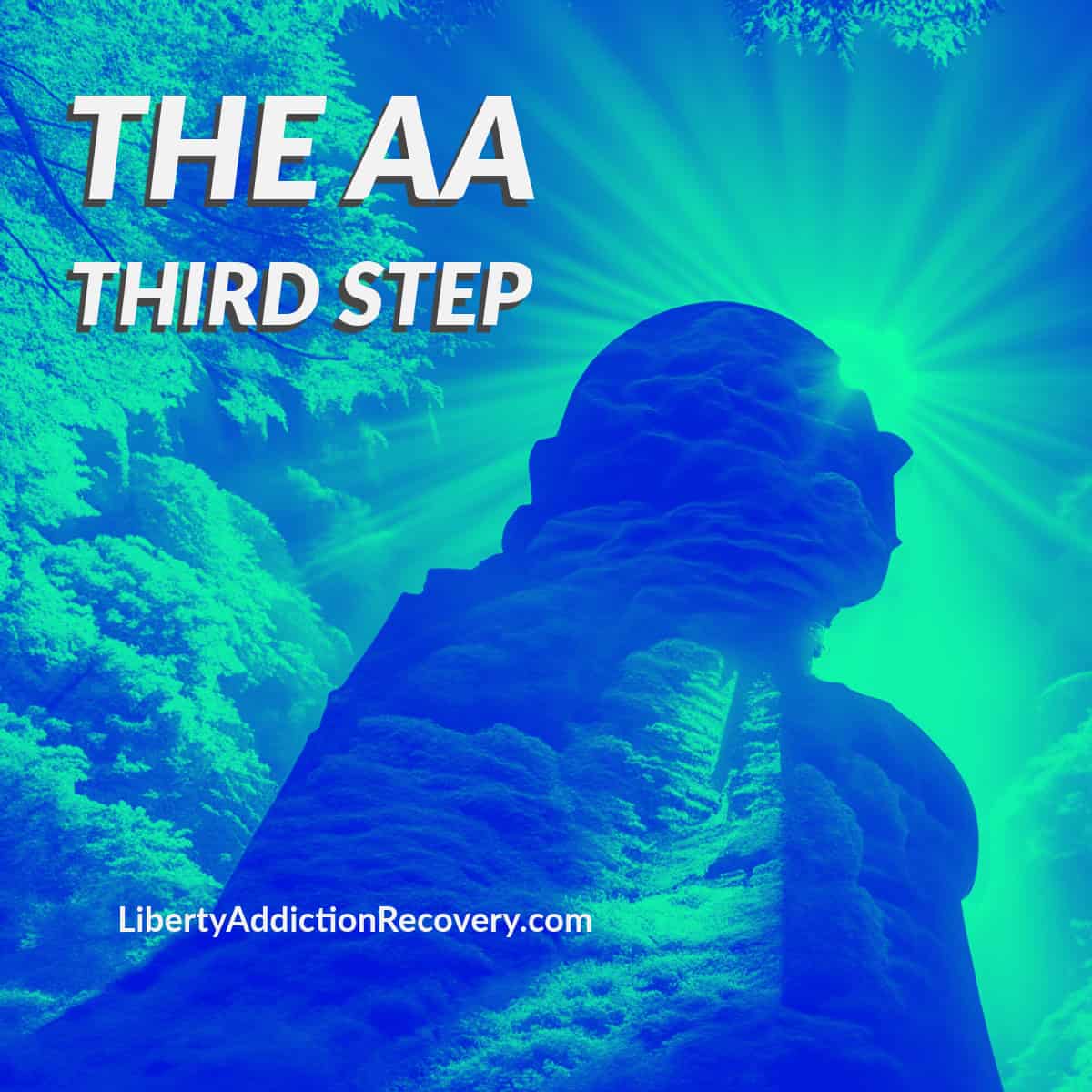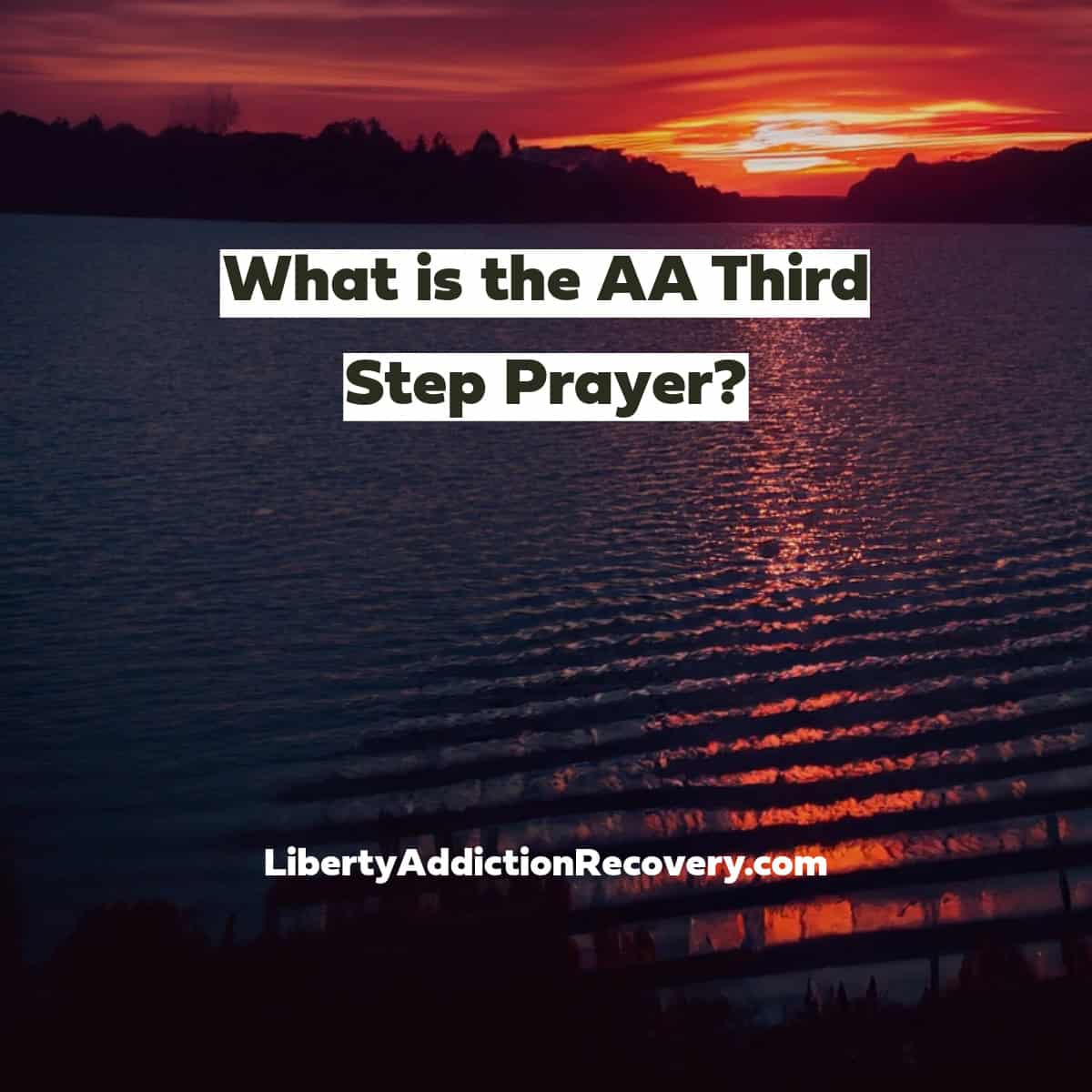When faced with the challenges of addiction, finding solace and strength to overcome one’s struggles is vital. Countless individuals on the path to recovery turn to the Alcoholics Anonymous (AA) program for guidance. At the heart of AA’s spiritual framework is the AA Third Step Prayer, a powerful articulation of surrender and faith. In this article, we’ll explore the AA Third Step Prayer, delve into its significance, and discuss its transformative impact on those grappling with substance abuse.

The AA Third Step Prayer
The Third Step Prayer is a pivotal element in the recovery journey—a heartfelt appeal for divine guidance and inner transformation:
“God, I offer myself to Thee—to build with me and to do with me as Thou wilt. Relieve me of the bondage of self, that I may better do Thy will. Take away my difficulties, that victory over them may bear witness to those I would help of Thy Power, Thy Love, and Thy Way of life. May I do Thy will always.” “Alcoholics Anonymous,” pages 63-64.
This prayer is the embodiment of the third step in Alcoholics Anonymous, which emphasizes the decision to “turn our will and our lives over to the care of God as we understood Him.”
It’s important to understand that for many, this prayer is a cornerstone of their daily recovery practice, offering a moment of reflection, hope, and a commitment to a new way of life. It acknowledges personal limitations and embraces the possibility of change through a Higher Power’s guidance.
In the following sections, we’ll delve deeper into the prayer’s line-by-line interpretation, reflect on personal stories of recovery, and provide practical advice on incorporating the Third Step Prayer into daily life.
Understanding the AA Third Step Prayer
Embarking on the journey of recovery entails more than physical abstinence; it requires a fundamental shift in one’s mindset and approach to life. The Third Step of Alcoholics Anonymous sets the stage for this transformation. It reads: “Made a decision to turn our will and our lives over to the care of God as we understood Him.” This step is about making a conscious choice to relinquish control, trusting that a higher power will guide you through the complexities of addiction.
This concept can be one of the most challenging for newcomers, as it necessitates openness to spirituality and the vulnerability of admitting that one cannot recover alone. It’s a declaration of the willingness to change and to place faith in something greater than oneself—whether that’s a traditional understanding of God, a personal interpretation of a higher power, or the collective spirit of the AA group itself.
Turning one’s will over doesn’t mean becoming passive or absent from the recovery process. On the contrary, it means actively engaging in the work necessary for sobriety, with the added support of a nurturing higher power. The AA Third Step Prayer is about partnership, not dominance. It’s an invitation to co-create a life beyond addiction, using spiritual principles as a foundation for growth.
The Role of the AA Third Step Prayer in Recovery
For many in recovery, the AA Third Step Prayer is not an isolated utterance but a daily practice—a spiritual touchstone that reiterates their commitment to sobriety. The prayer helps to center the mind, providing clarity and a sense of purpose. It serves as a reminder that the journey is not solely about abstaining from substances; it’s about cultivating a life aligned with higher principles and values.
The prayer gives voice to the internal struggle of addiction, acknowledging the “bondage of self” that so often hinders personal progress. It serves as a request for liberation from these inner chains, enabling individuals to pursue their true potential. By invoking divine support, the prayer facilitates a process of internal housecleaning, sweeping away the psychological debris that addiction leaves in its wake.
Through the inclusion of lines like “take away my difficulties,” it encourages individuals to see challenges not as obstacles but as opportunities for growth and service. Victories over personal difficulties become testimonies to share with others, offering hope and strength to those still struggling.
In recovery, the Third Step Prayer provides a compass for navigating the tough days. It fosters a sense of unity with a higher power and with fellow members of AA who share in the same practice. For many, it becomes a lighthouse in the fog of addiction, guiding them towards a safer shore. It is a daily affirmation that despite the struggles they face, they are not alone, and transformation is within their reach.
Related Article: 12 Steps of AA
Breaking Down the Prayer
The AA Third Step Prayer is a compact statement of intent and faith, but within its few lines, it contains multitudes of hope and determination. Let’s unpack the verses to appreciate their depth fully:
Offering of Self
“God, I offer myself to Thee—to build with me and to do with me as Thou wilt.”
This line represents the relinquishment of ego and the readiness to undergo the reconstruction of one’s life and character. As a builder uses materials to create a structure, individuals in recovery are offering themselves to their Higher Power as the raw materials for re-creation.

Relinquishing the Bondage of Self
“Relieve me of the bondage of self, that I may better do Thy will.”
Here lies the request to be freed from the suffocating grip of selfishness and self-obsession. These traits often drive addiction, and letting go of them can lead to a life of service and a commitment to a Higher Power’s will.
Transformation Through Trials
“Take away my difficulties, that victory over them may bear witness to those I would help of Thy Power, Thy Love, and Thy Way of life.”
Facing and overcoming difficulties is at the heart of personal transformation. This passage suggests that through such victories, individuals can demonstrate the power of recovery to others, inspiring them by example.
Lifelong Commitment
“May I do Thy will always.”
The closing line cements the lifelong dedication to living a life that reflects one’s spiritual beliefs and values, underscoring the permanence of this commitment to recovery and service.
These lines, when taken together, compose a daily roadmap for living soberly and purposefully. They affirm that strength and guidance are always available, and victory over addiction is attainable through faith and perseverance.

Personal Stories and Anecdotes
Personal accounts of the AA Third Step Prayer illustrate its real-world impact. For example, I recall a client named Michael who shared his journey with me. Michael had been struggling with alcohol addiction for years before he embraced the Third Step Prayer. Initially skeptical of anything that mentioned “God” or spirituality, Michael’s desperation led him to approach the prayer with an open mind.
He told me, “At first, it felt like just words. But as I kept repeating it, something clicked. It was like I wasn’t alone anymore. I wasn’t fighting my battles by myself.” Michael’s experience isn’t unique. Many people have found solace and strength in the AA Third Step Prayer, allowing it to guide them daily.
These stories serve not just as testimonials but as beacons of hope for others embarking on similar paths. Sharing these experiences can provide immense comfort and motivation to those still finding their way in recovery.
In the next sections, we will explore practical ways to integrate the Third Step Prayer into daily routines and discuss how prayer, in general, can aid in overcoming addiction.

Integrating the AA Third Step Prayer into Daily Life
Incorporating the Third Step Prayer into one’s daily routine can be a transformative practice, providing a foundation for the day ahead. Here are some practical steps to make this prayer an integral part of the recovery process:
- Morning Reflection: Start each day with the Third Step Prayer. Recite it upon waking to set a tone of surrender and intention for the day.
- Meditative Moments: Take a few minutes during the day to meditate on the prayer’s words, allowing them to resonate and guide your actions and decisions.
- Evening Gratitude: End the day by revisiting the prayer, reflecting on how you’ve lived out its principles and expressing gratitude for the strength it has provided.
Making the Third Step Prayer a staple in your daily activities can help reinforce your commitment to recovery and maintain a connection with your higher power.
The Power of Prayer in Overcoming Addiction
The role of prayer in addiction recovery extends far beyond ritual; it is a source of immeasurable strength and solace. The act of prayer, regardless of one’s specific belief system, can bring numerous benefits:
- Reduced Stress: Engaging in prayer can trigger the relaxation response, reducing stress levels and promoting psychological well-being.
- Greater Resilience: Regular prayer can bolster resilience, helping individuals face the challenges of addiction with a sturdier mindset.
- Enhanced Support: For those in a faith community, prayer can strengthen the feeling of connection and support, essential in the journey toward recovery.
In embracing prayer as part of the recovery journey, individuals tap into a powerful resource that nurtures both spiritual and mental health, laying a solid foundation for lasting sobriety.
In the following sections of this article, we’ll provide additional resources to deepen your understanding of the AA Third Step Prayer and offer guidance on seeking help if you or a loved one is struggling with addiction.
Additional Resources and Support
If the AA Third Step Prayer speaks to you, or if you’re curious to learn more about the role of spirituality in recovery, there are numerous resources available to aid in your understanding and practice:
- AA Meetings: Attend local or online AA meetings to connect with others who use the Third Step Prayer in their recovery. It’s a space to share experiences and find communal support.
- Spiritual Guidance: For those who are inclined, seeking the counsel of a spiritual leader or mentor can provide further insight into incorporating the Third Step Prayer into your life.
- Recovery Literature: Reading literature from AA, such as “The Big Book,” can deepen your comprehension of the Third Step and its accompanying prayer.
- Counseling Services: Speaking with a professional counselor or therapist specializing in addiction can help tailor recovery efforts to your unique needs, including spiritual practices like the Third Step Prayer.
Remember, help is always available, whether it’s through meeting others who are also on their recovery journey or through professional services. Never hesitate to reach out and explore the resources offered by organizations such as Liberty Addiction Recovery Centers.
Conclusion – AA Third Step Prayer
The AA Third Step Prayer serves as a powerful expression of hope and surrender for those looking to overcome the grip of addiction. By understanding and integrating this prayer into daily life, individuals can experience a profound shift in their approach to recovery, recognizing they are not alone in their struggles.
If you or a loved one is navigating the path of addiction, remember that there is always hope and assistance available. At Liberty Addiction Recovery Centers, we are committed to providing the support and resources necessary to help you or your loved one soar higher and further than ever before on the journey to sobriety. We believe in the power of recovery and the potential for everyone to build a life that thrives.
For more information on how Liberty Addiction Recovery Centers can assist you or if you have any questions regarding our programs, please visit our rehab centers in Utah page or contact us today. Our team is ready and eager to support you every step of the way towards a brighter, addiction-free future.






